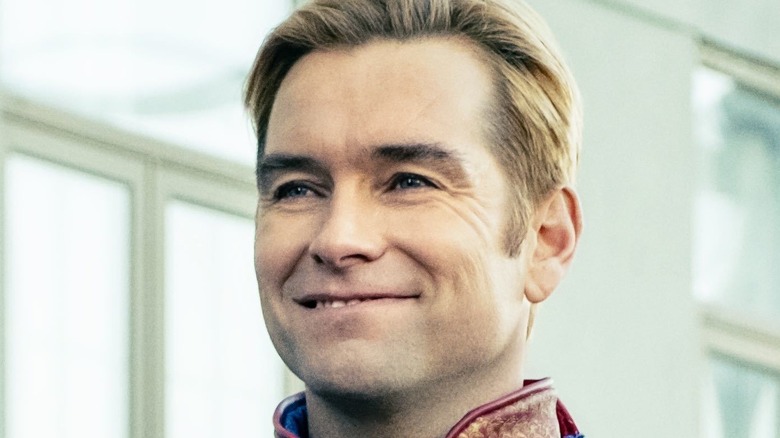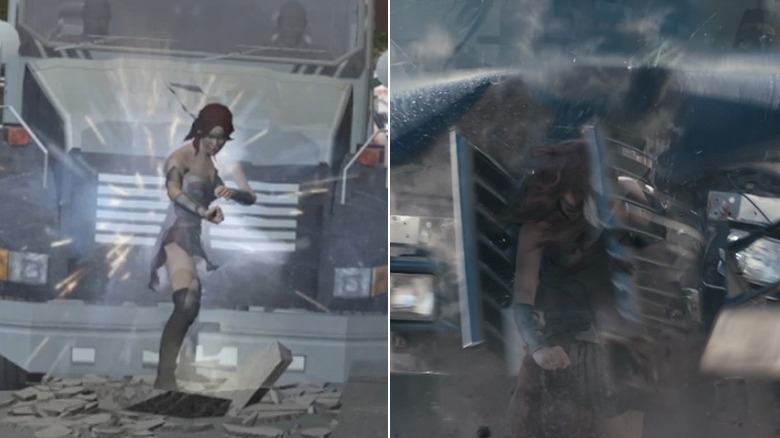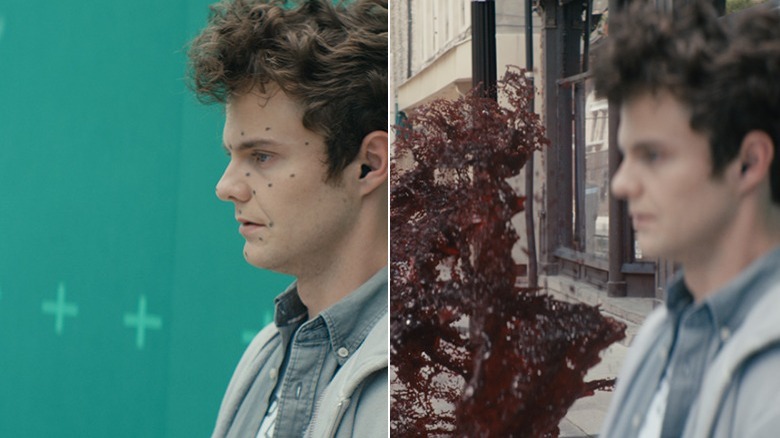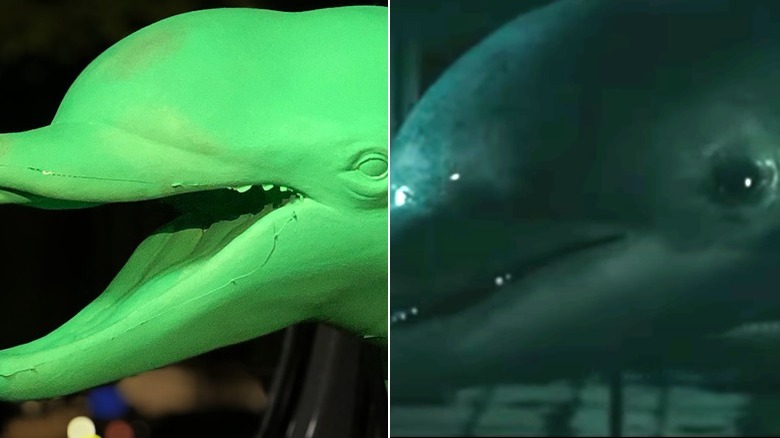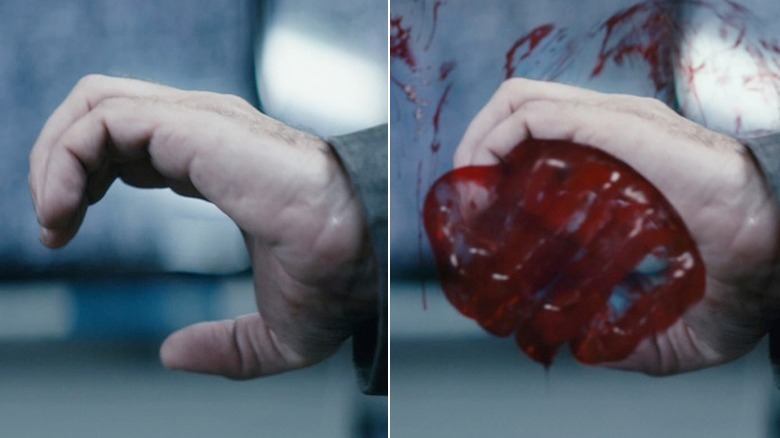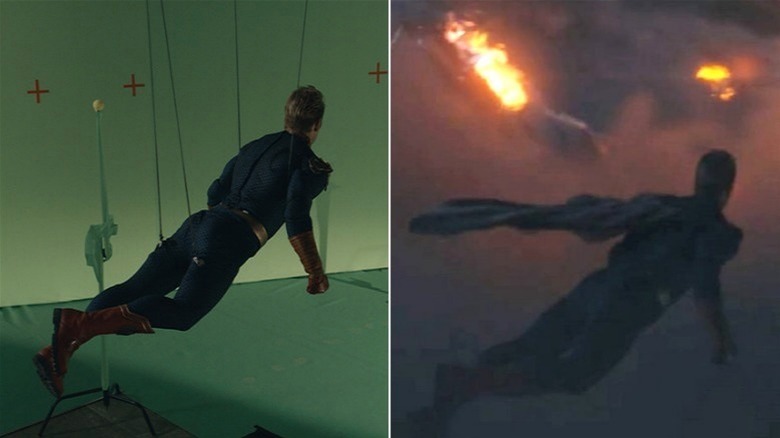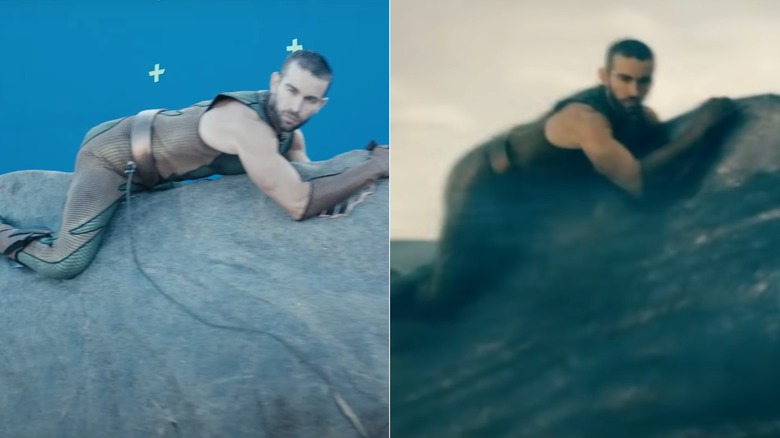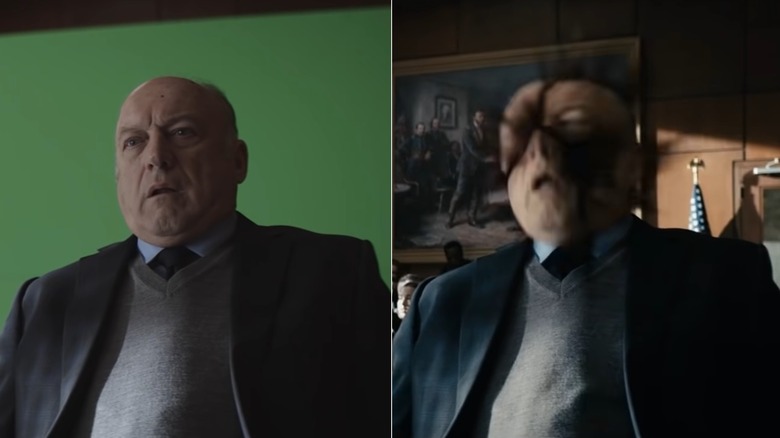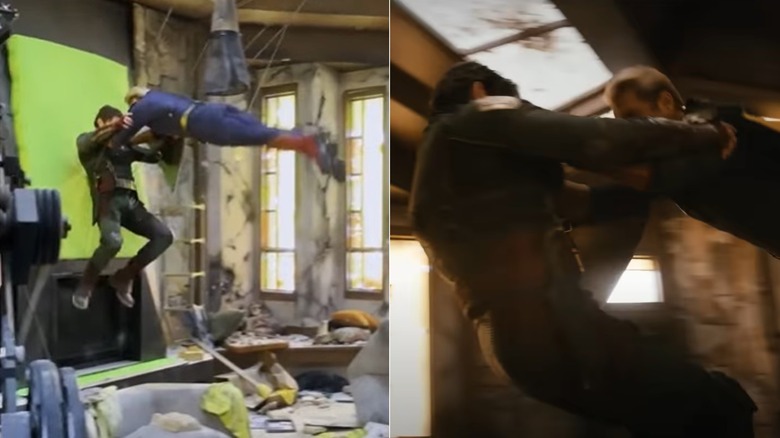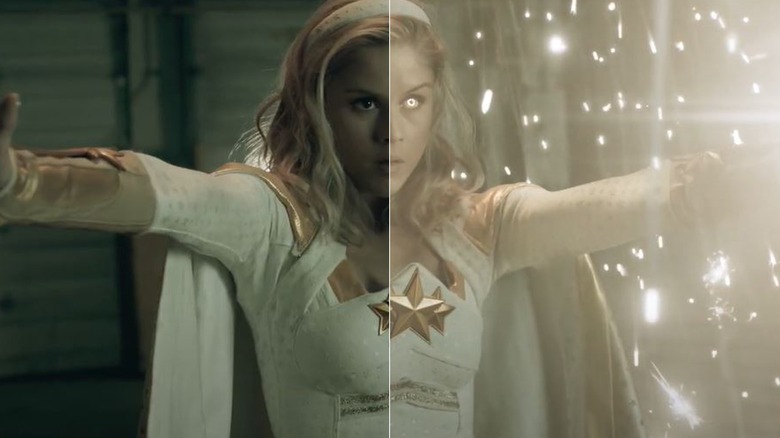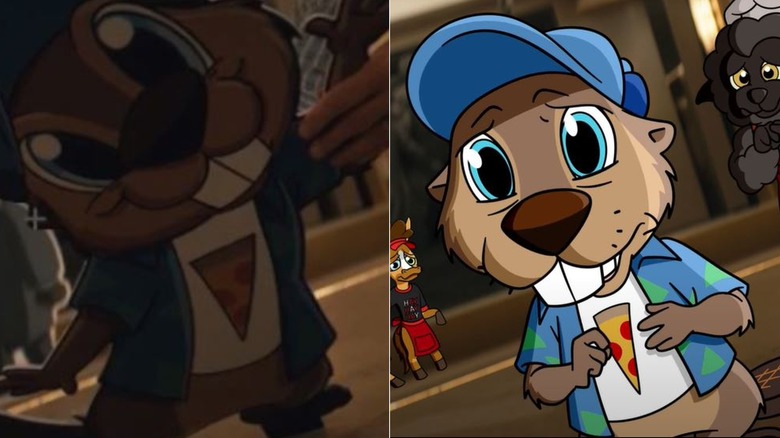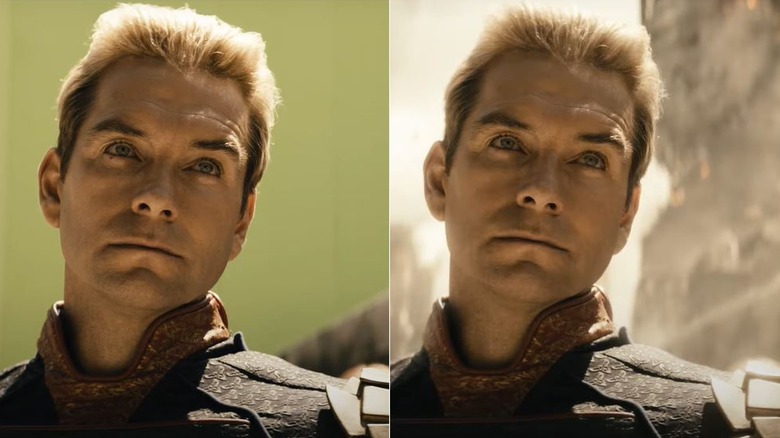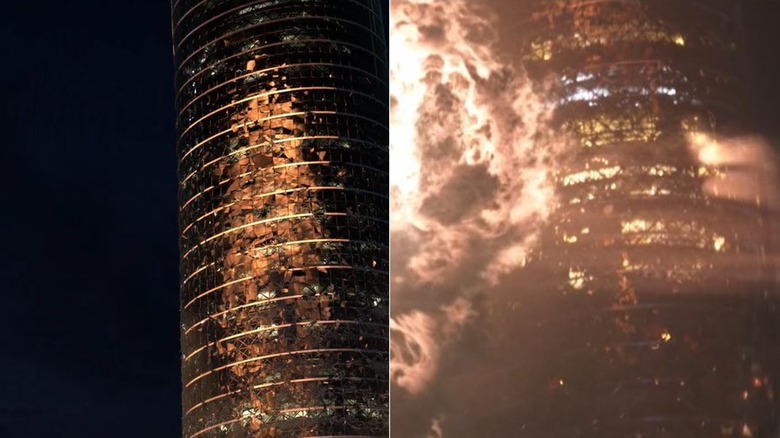What These Scenes From The Boys Look Like Without Special Effects
Anyone who's watched "The Boys" knows the creators don't shy away from blood, gore, and shocking fight scenes. The pilot episode alone has several scenes of superheroes — also known as Supes in this world — both using and abusing their powers as they fight anyone who dares to get in their way. Whether it's a Supe literally running through someone or shooting down a plane with their laser eyes, the show uses special effects to tell a story that's just as powerful as the characters in it.
It takes a combination of practical and visual effects to bring these spectacularly violent scenes to life on screen. Sometimes the team uses green screens and computer-generated imagery to create the desired effect, while other times, they build an entire rigged set to get the right shot. Although the results seem larger than life, Christopher Gray of the visual effects company Framestore (which has created several stellar VFX shots for "The Boys") notes the importance of tiny details. "In visual effects, 90% of it is in your face, and the detail is what really sells it," he told Den of Geek. "The subtleties and imperfections in the shots are what actually take it fully there for you."
Keep reading to find out what some of the most memorable scenes from "The Boys" looked like before special effects were added.
Queen Maeve stops an armored truck
The pilot episode starts off with an impressive scene of superheroes Homelander and Queen Maeve foiling an attempted bank robbery. During the dramatic sequence, Queen Maeve manages to stop an armored truck just by jumping in front of it. The truck crashes into her and she goes straight through it, halting the vehicle and saving the day without even breaking a sweat.
Surprisingly enough, this scene was mostly made with practical effects, although some visual effects were used as well. The team started by creating a previs (or previsualization) of the scene so that everyone was on the same page before filming began. From there, they used wires to drag a truck carcass into a big metal pole. They also captured a shot of McElligott jumping in front of a green screen, which was later integrated with footage of the crash.
To make it look like Queen Maeve was inside the truck as debris flew around her, the team actually built a special set. The whole set was on wheels, allowing them to move it around the actress while a fan blew on her hair. Later on, all the shots were combined and the debris was added with CGI.
A-Train runs through Robin
Who could forget that gut-wrenching scene in the pilot episode where Hughie's girlfriend Robin seemingly explodes out of nowhere? One moment, lovebirds Hughie and Robin are holding hands while saying goodbye. The next moment, she takes a small step onto the street, only for A-Train to run through her at superhuman speeds, tearing her completely apart. Hughie is left splattered with Robin's blood and guts while holding her severed hands.
The scene was filmed in front of a green screen with a Phantom high-speed camera at about 500 frames per second. The crew positioned the camera on a big robotic arm so they could move the camera quickly enough to get the perfect shot. "What you're seeing there when it's rounding around Hughie is one second of time being slowed down," explains Stephan Fleet, the visual effects supervisor, in an interview with VFX Voice. As for Robin's disintegrated body and the blood splattered on Hughie, the team tried using practical effects, but it didn't quite look the way they wanted. They ended up using CGI to create just the right amount of blood in the right places.
"It became about the storytelling," says Fleet. "How much of Robin do we see, how much of her guts do we see? How much blood do we see? What's the trajectory? There's probably more blood than a real human would have, but it would be a lot less interesting if it was a real situation. A-Train would pretty much atomize the person and there wouldn't even be as many guts and spines and stuff as you see there."
Failed dolphin rescue
Most of us can recall some memorable fight scenes in TV shows, but what about memorable dolphin scenes? If you can't think of any off the top of your head, you've got to check out Season 1 Episode 4 of "The Boys." The episode features a bizarrely violent scene of The Deep, a Supe who can communicate with aquatic life, trying to save a dolphin from an aquarium. He puts the dolphin inside the van in a position that seems safe — until he slams on the brakes during the escape, flinging the poor animal through the windshield and onto the street. It miraculously survives the impact, only for a truck to run it over and instantly kill it.
A dolphin puppet was used for the shots of The Deep speaking with the ill-fated creature throughout the scene. For the crash, the team built a green dolphin doll and a device to launch it through the windshield. The glass broke as this happened, lending a realistic look to the scene. "It was kind of one of those funny nights in visual effects, you know, you're working until five in the morning launching green dolphins out of a car," says Fleet. Soho VFX later replaced the green dolphin with a CG version that looked more like the real deal. "They also came up with the idea of him flopping on the ground before the truck hits him," adds Fleet. "Those little details make it great."
Translucent's invisible fight
The scene of Hughie and Butcher going up against the invisible superhero Translucent during the pilot episode is action-packed, to say the least. Translucent starts by pushing Hughie around, and things quickly escalate as Butcher crashes a car into the store, pushing Translucent through a bunch of shelves. Butcher and Translucent engage in a bloody fistfight until Hughie electrocutes the invisible Supe.
The shot of Butcher ramming into the store required building a duplicate set that the stunt coordinator rigged, complete with a rail system and camera that were both linked to a green "wrecking ball" on wires (which was later edited out) capable of smashing through real shelves. The setup was motion controlled so the team could repeat the movement until they got the right shot.
Butcher and Translucent's fistfight was filmed in a few different ways. First, Urban did the choreographed fight with a stunt double in a gray suit, who was later edited out. The actor then repeated the entire fight by himself. The special effects team used some shots with the stunt double, but the majority of the footage came from Urban fighting alone. Throughout the bloody brawl, Translucent is partially visible, thanks to Butcher spitting blood on him. The team used the stunt double as an animation reference for this part.
Homelander takes down a plane
Near the end of the first episode, the audience begins to understand just how cruel Homelander really is. The mayor of Baltimore and his son are on a plane when they see Homelander flying beside them. The mayor had previously attempted to blackmail the superhero company Vought, which leads Homelander to use his laser eyes to shoot down the plane. The superhero (or should we say supervillain?) watches with a slight smile as the plane catches fire, rips in half, and falls through the clouds.
To create this shocking scene, the crew filmed Homelander actor Antony Starr hanging on wires in front of a green screen. They combined that footage with CGI to create the final effect. Homelander uses his laser eyes many times throughout the show, and it was during this scene that the visual effects team refined the look of his most memorable superpower. "There's also a lot of subtlety and a lot of breakup in those lasers that make them slightly unique from your average CG laser eye gag and they play into his character," VFX supervisor Stephan Fleet told Befores & Afters.
"The final shot is really [director] Dan Trachtenberg's vision in doing a slow wrap-around reveal of Homelander's character," adds Fleet. "So, you get the plane ripping in half, which is awesome, it's probably the biggest spectacle thing we have in that episode, and then we meander the camera over to Homelander and see that little bit of a smile on his face and you realize, 'Oh this guy's a sociopath.'" This incredible attention to detail almost makes the Supes seem real — but after seeing this show, we're glad they're not!
A whale of an effect
There's a lot of blood and gore in the first season of "The Boys," but the creative team outdid themselves in Season 2. One of the most unforgettable moments in the sophomore season involves a speedboat plowing through a whale. The shocking moment was conceptualized by writer Craig Rosenberg, who fought to bring it to the screen. "I think he specifically wanted to top the dolphin," showrunner Eric Kripke told Entertainment Weekly. "I was initially reluctant, but he argued that there are only so many more times The Deep can kill marine life through his sheer incompetence."
The elaborate scene features The Deep riding a whale into the path of an oncoming speedboat, hoping to force the driver — Butcher — to stop. Unfortunately, Butcher decides to speed up instead of slowing down, impaling the whale and knocking The Deep out in the process. As the visual effects team told Variety, the boat was pulled on a rail by string into a model of the mammal. Meanwhile, the entrails exploded out of cannons shooting 150 gallons of fake blood onto stunt doubles. The entire whale set was built by hand, taking crews an estimated five months to create. "There's only one bluescreen shot in the entire sequence and that is when The Deep is actually on the whale," VFX supervisor Stephan Fleet said in a behind the scenes featurette.
Popping heads
One of the biggest mysteries in "The Boys" Season 2 has audiences wondering who's behind all the exploding heads. The power was introduced in the Season 2 premiere, with CIA deputy director Susan Raynor (Jennifer Esposito) losing her head in front of the protagonists. The most memorable instance of this brutal power being used takes place in Season 2 Episode 7, when a congressional hearing is thrown into chaos as craniums begin to explode seemingly at random.
Speaking with Corridor Crew, "The Boys" VFX supervisor Stephan Fleet revealed the mastery behind making heads pop for television. Much of the effect was developed in Season 1 when Translucent was taken out by an internal bomb. Fleet wanted to perfect the technique when they brought it back for the Susan Raynor scene, as he was tipped off about there being a lot more exploding heads in the show's future.
Fleet's technique requires what the VFX team refer to as a "blood lollipop," which doubles as the actor's head and is used to drench anyone near the victim in the scene with blood. The computer graphics team then makes a model of the cranium, filling in the larger chunks of brain and bone as they fly in multiple directions. Finally, the beheaded CGI body is given what Fleet calls "the necklace" — that's the "meaty flap" that remains on the body, he said. "This is one of my proudest accomplishments of Season 2 from a supervision standpoint," he said of the scene.
Homelander's fight with Soldier Boy
In Season 3 of "The Boys," it seems like the crew are finally going to find their ultimate weapon in the fight against the overpowered Supe Homelander. To their surprise, the weapon they discover is the powerful World War II hero known as Soldier Boy (Jensen Ackles). With the ability to cause radioactive bursts that level entire buildings, Soldier Boy is depicted as the equal to Homelander. Fans could not wait for these two characters to go toe-to-toe in a fight, and the big battle finally took place in Season 3 Episode 6 — the unforgettable "Herogasm." In the end, Soldier Boy gets help from Butcher and Hughie, who have taken to using Temp-V (a developmental drug that gives you powers for 24 hours).
Stunt coordinator John Koyama took the lead in bringing to life a superhero fight for the ages. "He'd film it like a full-on movie," said VFX supervisor Stephan Fleet to Befores & Afters. "He'll shoot coverage. He'd send edits. He'd get notes. I think he did 12 to 16 versions of that sequence alone before we even filmed it." Many of the stunts involved a collection of wires and green screens, and the gaps were filled with computer graphics. The most challenging part of the sequence was "getting that iconic shot of Butcher and Homelander hitting each other with lasers," said Fleet. "And finding the right balance between making it that thing that everybody knows in movies where two lasers hit each other, but not making it over the top because, well, that's not our show."
Starlight's star-bright powers
It could be argued that in a show all about superheroes, the only true hero is Starlight (Erin Moriarty). Aside from assisting the Boys through most of their attempts to destroy the powers that be, Starlight additionally attempts to be a beacon of good as a member of The Seven. Although audiences rarely get to see her use her talents, Starlight's ability to project light is one of the most underrated powers in the show, as made evident by her dominating the climactic final battle in Season 3 Episode 8, "The Instant White-Hot Wild."
A lot of attention went into how Starlight's powers work and how they are depicted on screen. Most the effort occurred back in Season 1 when Starlight had a one-on-one showdown with A-Train (Jessie T. Usher). Framestone, the VFX house behind the sequence, "worked on it quite attentively for 8 weeks," the company's executive producer Christopher Gray revealed in an interview with Den of Geek. The VFX artists took cues from real-world science for the shining Supe's powers. "We looked at a thing called Femto-photography, which is like a way of visualizing photons," Gray explained. "It's a quick sequence, but you see all those little details in it. And it was really fun to do a bit of studying."
Black Noir's animated friends
One of the strangest things to ever take place in "The Boys" (and that's saying something) occurs in Season 3, when Black Noir begins having visions of animated, Disney-like characters. The cartoon sequences were an unexpected fan-favorite addition to the series, mostly thanks to the obscene things the animated animals say. As seamless as the series made it look, developing hybrid scenes with live-action and 2D animation was a complicated process.
The development of the cartoon characters and the animation was done by Six Point Harness. Using their designs, the live-action VFX team created cut-outs of the animals to fit the scale of the scenes. "My office was filled with cut-outs of these cartoon characters," Stephan Fleet told Befores & Afters, explaining how his team "would juggle popping them in to frame for reference, line up, sometimes even acting out character motions. I'm sure there's some really goofy dailies out there that someone could use to embarrass us!" It wasn't all fun and games, though: The crew had to pay extra attention to certain light beams, making sure to incorporate them into the cartoon illustrations. "It's one of my favorite things in the show so far, how we pulled off that animation," said Fleet.
The Dawn of the Seven trailer
Mocking the real-world saturation of superhero movies in theaters, there are a lot of fake movies in "The Boys." Throughout the series, it is an ongoing joke that each member of The Seven has their own stand-alone feature film. However, one faux film was given far more screen time than the others, "Dawn of the Seven." A subplot featured throughout Season 2 of the series is the development of the big crossover movie, akin to "The Avengers" or "Justice League." The in-universe flick even received a real-world trailer, debuting as a meta teaser for Season 3 of "The Boys."
Unsurprisingly, the making of a fake superhero epic shares a lot of similarities with real-world blockbusters. VFX studio Rising Sun Pictures has revealed much of the work that went into making this mock movie with a special making-of breakdown. Filming was completed on practical sets designed to simulate a city in ruins, including a broken-down bus and the standard concrete rubble. A green screen was used to add in the apocalyptic background and help "Dawn of the Seven" emulate your favorite superhero flicks.
The explosive Season 3 finale
One of the most impressive parts of watching "The Boys" is how well it builds a world that is so similar to our own while maintaining the feel of another universe. Much of the series is recorded in real-world locations around Toronto, Canada. There are many examples of beloved settings in the Great White North that have been transformed to fit the series, including Canada's Wonderland theme park becoming Voughtland and Toronto's Roy Thomson Hall being the headquarters of Vought Industries and The Seven.
The use of these real-world locations becomes even more interesting when something catastrophic happens in "The Boys." A prime example comes at the conclusion of Season 3 when Soldier Boy is thrown out of Vought Tower and explodes amongst the skyline of skyscrapers. There are multiple layers to such a jaw-dropping effect. A VFX highlight reel released by Rocket Science shows CGI buildings superimposed over footage of Toronto's downtown as Soldier Boy falls from the building. This technique allows the VFX team to showcase the impact of the Supe's exploding powers while maintaining those real-world connections that have formed the foundation of the series.
That ill-timed sneeze
There is one scene that fans of "The Boys" will likely never forget, no matter how badly they want to erase it from their minds. It takes place in the Season 3 premiere, "Payback." Without going into too much detail, the scene in question involves a size-shrinking Supe named Termite climbing inside a certain male body part. When he sneezes and inadvertently reverts to his normal size, he explodes his romantic partner from the inside. He's left shocked and covered from head to toe in blood. The idea for the scene came about after the creative team saw all those memes about Marvel's Ant-Man defeating Thanos by "crawling up his butt and expanding," as Know Your Meme puts it.
Equal parts hilarious and disturbing, the sequence was achieved through a mixture of practical and CGI effects. The props that Termite uses needed to be supersized, including the male genitalia he climbs inside. "The art department built a practical penis entrance set — an 11-foot-high, 30-foot-longish representation of the penis," VFX supervisor Stephan Fleet told Befores & Afters. "The practical entrance was key for the performer to do his fantastic, and very real, swan dive." The explosion ended up being one of the biggest challenges for the team, who used CGI for the big moment, though a blood bag was also used for reference. "One of the things we always try and do is explode a blood bag anywhere where we're going to do a head explosion or a body explosion or anything like that," Fleet said.
